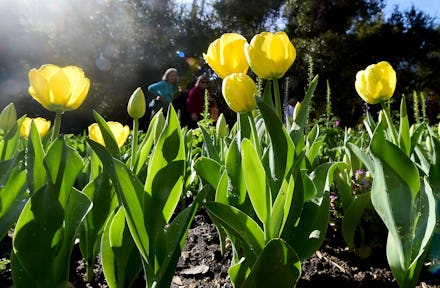6 Myths About Spring We Should Stop Believing

Goodbye, winter. For the Northern Hemisphere, spring officially springs into place at 7:21 p.m. Eastern on Sunday, according to National Geographic. The day is also known as the vernal equinox or spring equinox — with equinox meaning "equal light" in Latin, referring to the approximately 12 hours of both day and night the date receives, according to the Washington Post.
With the change in seasons, longer daylight hours and warming temperatures also comes a slew of legends and myths. In many parts of the world, the day is a time of spiritual rebirth, according to Refinery29. That's because astronomers have been studying this natural transition for centuries, specifically examining the positions of the sun and stars, according to Discovery News.
Read more: Daylight Saving Time Doesn't Just Cost You Sleep — There May Be Hidden Health Hazards Too
Below are six myths and legends that come with the majestical-sounding spring equinox:
1. Day-to-night equality always happens on the equinox.
This varies based on where you're located on Earth. The true definition of equinox is when the center of the sun passes over the equator, according to National Geographic. Due to the shape, angle and rotation of the Earth and its atmosphere, the timing of the equinox doesn't always align with precisely equal times night and day. Instead, there's typically more daylight during the spring equinox.
2. You can balance an egg upright during the equinox.
This urban legend has little scientific evidence, according to the Washington Post. If you try hard enough, you can balance an egg any day of the year. The same goes for brooms.
3. People are horniest during the spring.
Is it the blossoming flowers? The buzzing bees? The chirping birds? No, because people actualy aren't horniest in the spring, but rather in the winter and summer, according to the Science of Relationships. Research links sexual drives and mating behaviors to cycles of six months.
4. For some, the spring equinox isn't even the first day of spring.
Astronomers and the general public like to consider the vernal equinox the mark of spring, but meteorologists and climate scientists, who base seasons off of climate, associate the start with March 1, according to the Washington Post. Even more confusing is if the Irish Celtic tradition is used — which defines spring by the amount of daylight — then spring began on Feb. 1.
5. Spring is warmer than fall.
Contrary to popular belief, the coming of spring doesn't always mean warmer weather, according to the Washington Post. Maybe it's the juxtaposition from ugly winter, but spring as a whole is usually colder than fall.
6. At noon during the equinox, someone's shadow won't be cast.
While the sun's new angle will change someone's shadow, it would take almost perfect circumstances to avoid casting a shadow, according to Accuweather. The sun would have to be directly above someone standing right at the equator when the clock strikes noon.